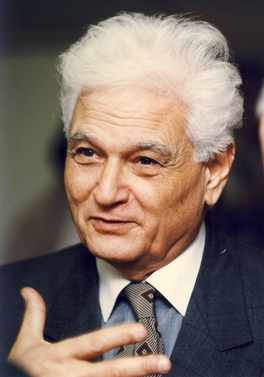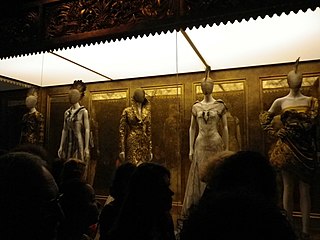Related Research Articles
In philosophy, deconstruction is a loosely-defined set of approaches to understanding the relationship between text and meaning. The concept of deconstruction was introduced by the philosopher Jacques Derrida, who described it as a turn away from Platonism's ideas of "true" forms and essences which are valued above appearances.

Postmodernism is a term used to refer to a variety of artistic, cultural, and philosophical movements that claim to mark a break from modernism. They have in common the conviction that it is no longer possible to rely upon previous ways of depicting the world. Still, there is disagreement among experts about its more precise meaning even within narrow contexts.

Jacques Derrida was a French philosopher. He developed the philosophy of deconstruction, which he utilized in a number of his texts, and which was developed through close readings of the linguistics of Ferdinand de Saussure and Husserlian and Heideggerian phenomenology. He is one of the major figures associated with post-structuralism and postmodern philosophy although he distanced himself from post-structuralism and disavowed the word "postmodernity".

Rei Kawakubo is a Japanese fashion designer based in Tokyo and Paris. She is the founder of Comme des Garçons and Dover Street Market. In recognition of the notable design contributions of Kawakubo, an exhibition of her designs entitled Rei Kawakubo/Comme des Garçons, Art of the In-Between opened on 5 May 2017 at the Metropolitan Museum of Art in Manhattan, modeled by Rihanna.

The Parc de la Villette is the third-largest park in Paris, 55.5 hectares in area, located at the northeastern edge of the city in the 19th arrondissement. The park houses one of the largest concentrations of cultural venues in Paris, including the Cité des Sciences et de l'Industrie, three major concert venues, and the prestigious Conservatoire de Paris.

Mark Antony Wigley is a New Zealand-born architect and author based in the United States. From 2004 to 2014, he was the Dean of Columbia University's Graduate School of Architecture, Planning and Preservation.

Deconstructivism is a postmodern architectural movement which appeared in the 1980s. It gives the impression of the fragmentation of the constructed building, commonly characterised by an absence of obvious harmony, continuity, or symmetry. Its name is a portmanteau of Constructivism and "Deconstruction", a form of semiotic analysis developed by the French philosopher Jacques Derrida. Architects whose work is often described as deconstructivist include Zaha Hadid, Peter Eisenman, Frank Gehry, Rem Koolhaas, Daniel Libeskind, Bernard Tschumi, and Coop Himmelb(l)au.
Martin Margiela is a Belgian fashion designer, artist, and founder of the French luxury fashion house Maison Margiela. Throughout his career, Margiela has maintained a low profile, refusing to grant face-to-face interviews or be photographed. Since leaving fashion in 2008, he has emerged as an artist, exploring the themes that made him an iconic figure in fashion. He is considered to be one of the most influential fashion designers in recent history for his iconic deconstructed, upcycled aesthetic and oversized silhouette.

Dover Street Market is a multi-brand retailer originally located on Dover Street, in Mayfair, London. It has stores in New York City, Tokyo, Singapore, Paris, Beijing and Los Angeles.

Fashion design is the art of applying design, aesthetics, clothing construction and natural beauty to clothing and its accessories. It is influenced by culture and different trends and has varied over time and place. "A fashion designer creates clothing, including dresses, suits, pants, and skirts, and accessories like shoes and handbags, for consumers. He or she can specialize in clothing, accessory, or jewelry design, or may work in more than one of these areas."

Olivier Zahm is a French magazine editor, art critic, art director, curator, writer, and photographer He is the co-founder, owner, and current editor-in-chief of the bi-annual art and fashion magazine Purple. In addition to his innovative print publishing, he is a recognized pioneering cultural influence at the dawn of the electronic era during the Digital Revolution. His early blogs garnered notoriety, and featured highly stylized photographs taken by him, that took his audience on daily tours of his fantasyland populated by the artists, intellectuals, designers, filmmakers, socialites, models and celebrities who regularly appeared in his magazine. His aesthetic has been described as anti-fashion, counterculture, and unfettered by the constraints of the mainstream publishing world. His online activity served as an early electronic precursor to popular social media platforms like Facebook and Instagram. His magazine remains one of the only independent and privately owned publications of its kind. Created in the beginning of the 1990s – it still remains a major reference for other alternative magazines today.

Anti-fashion is an umbrella term for various styles of dress that are explicitly contrary to the fashion of the day. Anti-fashion styles may represent an attitude of indifference or may arise from political or practical goals which make fashion a secondary priority. The term is sometimes even used for styles championed by high-profile designers, when they encourage or create trends that do not follow the mainstream fashion of the time.

Richard Martin was an American scholar, lecturer, critic and curator, and a leading art and fashion historian. At the time of his death he was curator of the Costume Institute at the Metropolitan Museum of Art, creating many critically acclaimed exhibitions and contributing widely towards publications on the subject. After his death, an award in his name was set up to recognise creative, high quality and innovative costume exhibitions.

A fashion museum is dedicated to or features a significant collection of accessories or clothing. While there may be some overlap with Textile museums, fashion museums focus on what trends in clothing and accessories reveal about the larger cultural, social, and economic values of different historical periods. Although fashion is a broad term that applies to more than just clothing items, these provide tangible examples of trends changing over the years which explains why the term fashion museum is most commonly referring to those featuring clothes.

Comme des Garçons, also CDG for short, is a Japanese fashion label based in Paris, founded by Rei Kawakubo. Its French flagship store is located in Paris, while its other physical retail stores are in London, Berlin, Melbourne, Seoul, Hong Kong, New York City and in the Aoyama district of Tokyo. Other than fashion, the label has expanded to include jewelry and perfume.

The Anna Wintour Costume Center is a wing of the Metropolitan Museum of Art main building in Manhattan that houses the collection of the Costume Institute, a curatorial department of the museum focused on fashion and costume design. The center is named after Anna Wintour, the longtime editor-in-chief of Vogue, Chief Content Officer of Condé Nast, and chair of the museum's annual Met Gala since 1995. It was endowed by Lizzie and Jonathan Tisch. As of August 2017, the chief curator is Andrew Bolton.
Maison Margiela, formerly Maison Martin Margiela, is a French luxury fashion house founded by Belgian designer Martin Margiela and Jenny Meirens in 1988 and headquartered in Paris. The house produces both haute couture-inspired artisanal collections and ready-to-wear collections, with the former influencing the designs of the latter. Product lines include womenswear, menswear, jewellery, footwear, accessories, leather goods, perfumes and household goods. Known for deconstructive and avant-garde designs with unconventional materials, Maison Margiela has traditionally held live shows in unusual settings, for example empty metro stations and street corners. Models' faces are often obscured by fabric or long hair to direct attention to the clothes and design. Margiela resigned as creative designer in 2009. John Galliano was appointed to the role in 2014, and resigned in 2024. The identity of his successor is unknown.

Andrew John Bolton is a British museum curator and current head curator of the Anna Wintour Costume Center at the Metropolitan Museum of Art in New York City, the host venue for the annual Met Gala.

Rei Kawakubo/Comme des Garçons Art of the In-Between was an art exhibition about the work of fashion designer Rei Kawakubo and her designs for her fashion house, Comme des Garçons. The exhibition ran from May 4 to September 4, 2017, at the Metropolitan Museum of Art. It was curated by Andrew Bolton, who worked closely with Kawakubo to select works for the exhibition. On display were 140 women's costumes spanning the entirety of her career until 2017. This exhibit represents Kawakubo in an immersive world of Gesamtkunstwerk, "total work of art".
In semiotics, a parergon is a supplementary issue or embellishment.
References
- 1 2 Granata F. Deconstruction and the Grotesque: Martin Margiela / Experimental Fashion: Performance Art, Carnival and the Grotesque Body. London — New York, I.B.Tauris: 2017. p. 74 — 102.
- ↑ Gill A. Deconstruction Fashion: The Making of Unfinished, Decomposing and Re-Assembled Clothes // Fashion Theory: The Journal of Dress, Body & Culture. 1998. Vol. 2.1. Pp. 25.
- 1 2 3 Avtonomova N. S. Derrida and grammatology // Derrida J. On grammatology. M.: Ad Marginem, 2000. - P. 7-107.
- 1 2 3 Gill A. Jacques Derrida: fashion under erasure. / A. Rocamora & A. Smelik (Eds.), Thinking Through Fashion: A Guide to Key Theorists. London: I.B. Tauris, 2016. pp. 251—268.
- 1 2 Koda H. Rei Kawakubo and the Aesthetic of Poverty / Costume: Journal of Costume Society of America, 1985, No. 11, pp. 5-10.
- ↑ Martin R., Koda H. Infra-Apparel. [Exhibition catalogue]. New York: Metropolitan Museum of Art, 1993.
- 1 2 3 Johnson P., Wigley M. Deconstructivist architecture [Catalog of the Exhibition]. New York: Museum of Modern Art, 1988.
- ↑ Gill A. Deconstruction Fashion: The Making of Unfinished, Decomposing and Re-Assembled Clothes // Fashion Theory: The Journal of Dress, Body & Culture. 1998. Vol. 2.1. p. 25.
- 1 2 Wilcox C. Radical Fashion. [Exhibition catalogue]. London: V & A Publications, 2001.
- ↑ Brunette P., Wills D. Deconstruction and the Visual Arts: Art, Media, Architecture. Cambridge: Cambridge University Press, 1994.
- ↑ Spindler A.M. Coming Apart // New York Times. 1993. July 25. Styles section. Pp. 1, 9.
- ↑ O'Shea S. La mode Destroy // Vogue (Paris), 1992, May.
- 1 2 McLeod M. Undressing Architecture: Fashion, Gender, and Modernity // Architecture: In Fashion / Ed. by D. Fausch et al. Princeton: Princeton Architectural Press, 1994.
- ↑ Wilcox C. Radical Fashion. [Exhibition catalogue]. London: V & A Publications, 2003.
- ↑ Gill A. Deconstruction Fashion: The Making of Unfinished, Decomposing and Re-Assembled Clothes // Fashion Theory: The Journal of Dress, Body & Culture. 1998. Vol. 2.1. pp. 26-27.
- ↑ Martin R. 1992. Destitution and Deconstruction: The Riches of Poverty in the Fashion of the 1990s. // Textile & Text, 1992, vol. 15, No. 2, pp. 3 — 12.
